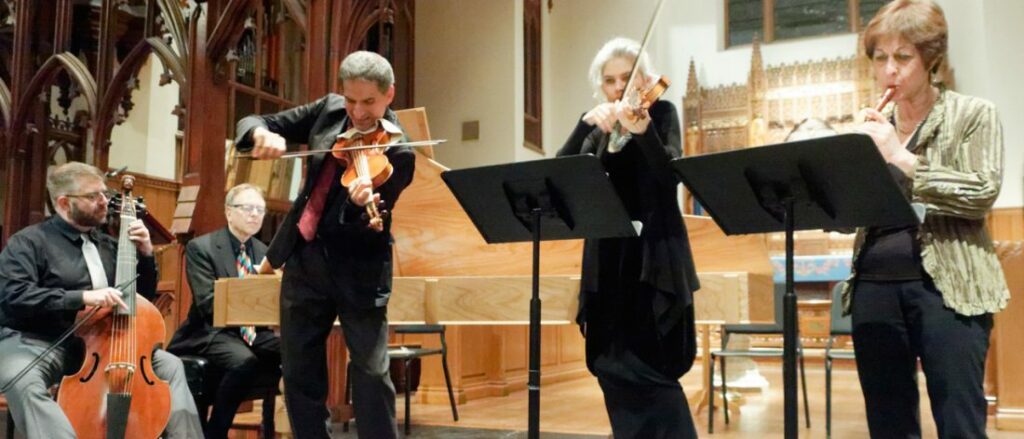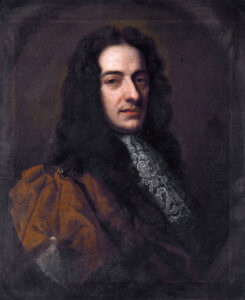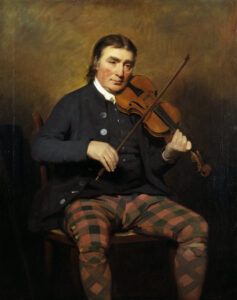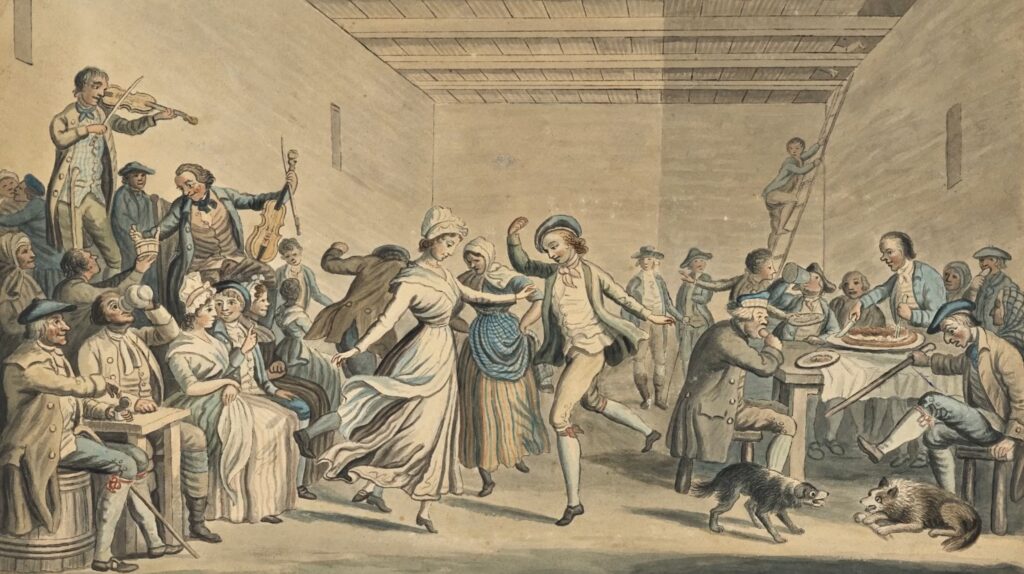For our February concert, SFEMS embarks on another journey to the remoter borderlands of early music. One of our most beloved and venerable ensembles, Musica Pacifica (Judith Linsenberg, recorders; Ingrid Matthews, violin; William Skeen, cello; Charles Sherman, harpsichord; and Peter Maund, percussion) returns with a program of exciting 18th-century Scottish traditional and baroque music. In this high-energy, foot-tapping program, Cape Breton’s driving strathspeys and reels, soulful airs and merry jigs are heard alongside more studied compositions of Purcell, Barsanti, and Matteis and The Division Violin. The music of ancient Scottish composers James Oswald, “Red Rob” Mackintosh, and Niel Gow will delightfully blur distinctions between classical and folk music. This concert is a follow-up to the group’s highly successful “Dancing in the Isles” program and CD. Musica Pacifica has released 9 CDs over the past 3 decades, and according to founder and recorder player Linsenberg, Dancing in the Isles has been by far the most popular.
Joining Musica Pacifica for these performances will be David Greenberg, baroque violinist and Cape Breton-style fiddler extraordinaire. Greenberg has been praised as both “one of the most impassioned folk-fiddlers you’ll ever hear,” (Winnipeg Free Press) and “the best baroque violin soloist in Canada, if not North America” (Halifax Mail-Star). He and Judith Linsenberg contributed these notes:

During the 17th and 18th centuries, an astounding range of musical styles, influences and cultural survivals co-existed in the British Isles. At the same time the most fashionable continental musicians were transforming the cultural life of London, centuries-old Irish and Scottish culture was being preserved in the rural villages of the rugged northwestern outerlands, where Celtic languages are spoken to this day. A growing cultural fluidity added to this mix, so that composers and audiences began to grow accustomed to a blending of musical styles and idioms from across the British Isles and throughout the European continent.
For this program, David has taken two main components of the Cape Breton music experience and adapted them for a baroque ensemble. Where he’s arranged Cape Breton, Scottish, and Gaelic-song tunes for the ensemble, there is a strong taste of the one-player-and-accompaniment feeling before it becomes irresistible to get everyone involved in the fun. Also, music throughout the program is presented in the form of medleys, whether or not we happen to be playing folk music or art music at the moment! You may love this, you may hate this, or it may confuse you, but at least you probably won’t be bored.

The concert opens with a wild Cape Breton-style set of tunes. Bòg an Lochain (also known as Athole Cummers) is an energetic strathspey that is often played for Cape Breton stepdancing. Beloved Cape Breton fiddler Winston “Scotty” Fitzgerald popularized Mrs. J. Forbes reel in the mid-20th century. Mains of Gartly follows, written by James Scott Skinner. He was one of the most influential violinists in the revival of the Scottish music tradition towards the end of the 19th century, after the time of the Highland Clearances (1780–1850) when the more ancient Highland Scottish style largely disappeared from Scotland and took root instead on Cape Breton Island in Nova Scotia. Though Skinner never set foot on Cape Breton Island, his compositions are frequently played there to this day.
Robert Mackintosh is a composer who would have been fascinating to meet. Apparently he had flaming red hair and a temper to match, and was known by the moniker, “Red Rob” Mackintosh. His folk tunes are often quite astonishing in their complexity and audacity, but great fun to play once you figure them out. He also wrote quite a few more refined compositions, such as the first four movements in this suite, and like James Oswald, he had no qualms about sharing space in his publications between folk repertoire and art music.
“The Lass of Patie’s Mill” is one of the most published tunes of the period, appearing in at least 23 early Scottish collections. Lady Mary Hay’s Scotch Measure was composed by Nathaniel Gow, the most well-known of Niel Gow’s eight children. He was an excellent fiddler, having studied with Robert Mackintosh in Edinburgh, as well as a prolific composer, with over 200 tunes to his credit. “Peggy I Must Love Thee” is by Francesco Barsanti, an Italian who lived in Edinburgh for eight years and married a Scots girl. His A Collection of Old Scots Tunes (1742) contained 28 Scots airs arranged for harpsichord or solo melody instrument with figured bass. Because of the influence of Barsanti and other transplanted Italian composers, Scottish art music had an Italian tilt. “Maggie Lawder” is best known as a song, with an affectionate and humorous description—read by some as an extended double-entendre—of an encounter between Maggie and Rob the Ranter, a Border piper. There are multiple versions of the tune in the Scottish fiddle literature. Oswald published it, with variations, in his Caledonian Pocket Companion (1742–59) and in a version with an added figured bass in his Collection of Curious Scots Tunes (ca. 1742). “Calum Crubach” and “Muileann Dubh” are popular stepdance tunes in Cape Breton, and they both are sung as puirt a beul (Gaelic mouth music) as well.
The next suite jumps among theatre pieces by Henry Purcell (1659–95). Selected movements from The Indian Queen [First Music and Second Music: Hornpipe], The Fairy Queen [Second Music: Air], Dioclesian [Canaries], and King Arthur [Song Tune] are rearranged into the present order. These pieces were originally scored for orchestra. We use the harpsichord either to fill out the missing orchestral parts (second violin and viola) or else to add extra rhythmic backbone when it befits the character, as in the first measures of the opening overture-like First Music from The Indian Queen, in the fiery Second Music: Air from The Fairy Queen, and in the jig-like section of Canaries from Dioclesian.
In his Caledonian Pocket Companion, Book IIII (1752), James Oswald (ca. 1711–69) set the melody of Purcell’s Hornpipe from The Fairy Queen on the same page as “The Lads of Leith,” a traditional air. Because of the nature of the Pocket Companion, the two tunes appearing together suggests that one tune reminded Oswald of the other, and possibly even that Oswald liked to play them one after the other as we do here. “The Lads of Leith” is one of the melodies which Robert Burns borrowed from Oswald’s Pocket Companion for his verses. In Cape Breton, “The Lads of Leith” is played as a jig and is known as “Beauties of the Ballroom” because it was arranged and published by J. Scott Skinner in a collection by that name. Buddy MacMaster’s three-part setting is modal (a combination of mixolydian and dorian—two of the most common modes in Celtic music) rather than minor), which helps give it a Cape Breton flavour.
Finally, “Sodger Lad” is an old-fashioned traditional jig whose early sources include Henry Playford’s Apollo’s Banquet … Several New Scotch Tunes for the Treble Violin (London, 1663–1690). As is the case with some other “traditional” tunes of unknown origin, “Sodger Lad” probably was a song, as it appears in William Thomson’s Orpheus Caledonius … (Collection of the Best Scotch Songs) vol. 2 (1733). Later it was included in many fiddle-tune collections, including the Gows’.

James Oswald was a composer, concert promoter and music publisher who began his career as a dancing instructor in the Scottish lowlands. Like Mackintosh, he was comfortable in both traditional music and art music genres. He published a hugely popular “Collection of Curious Scots Tunes” in Edinburgh around 1740; among this collection was his Sonata of Scots Tunes. It is a characteristic hybrid in which Scots folk tunes are provided with a fashionably Corellian bass line, and pieces of different character are juxtaposed to form a delightful entertainment, more for the salon than for the dance-hall. To the end of this sonata, David added Blue Bonnets O’er the Border, a popular Cape Breton jig. This jig, as it turns out, is simply a more lively setting of the melody used for O Dear Mother which begins the piece.
Nicola Matteis was the earliest notable Italian violinist in London, whom Roger North judged in retrospect “to have bin a second to Corelli,” and a composer of significant popularity in his time. He enjoyed great artistic and commercial success with his published music, notably four books of Ayres (1676, 1685), Unusually, these volumes contain great numbers of individual movements which are organized only by key, allowing performers to create suites of their own choosing. This ciacona’s subtitle (“Diverse bizzarie sopra la vecchia ciacona”) refers to “various oddities,” and indeed it is full of surprises and high spirits over the well-known bass pattern. In 1700 Matteis married a rich widow and retired from the London musical scene; but according to North he nevertheless ended his days sadly, as “an excess of pleasure threw him into a dropsyes, and so he became poor and dyed miserable.”
The lament Niel Gow composed in 1805, following the death of his second wife, Margaret Urquhart, is one of the most recognized and beloved airs in all of the Scottish music repertoire. David composed a bassline to the melody which he hopes Niel’s brother Donald would have enjoyed playing on the cello.
All the tunes in The Pinkie House set are from old Scottish collections. “Pinkie House” was evidently one of the most popular tunes of the ‘Golden Age of Scottish Fiddle’ (roughly 1750–1820) since this air was published repeatedly in numerous music collections of this period. However, it somehow hasn’t entered the modern Cape Breton repertoire, unlike the tunes that follow it in this medley, all of which are played in Cape Breton today. David composed a bass line for the tunes following “Pinkie House” that reflects the intricate and fun chromatic ‘walking-bass’ style accompaniment that Cape Breton piano players are known for. This kind of bass line (along with syncopated activity in the right hand) adds to the feeling of a driving yet rooted ‘flow’ that is so vital and infectious in the Cape Breton style.

In a program of primarily Scottish tunes and dances, Henry Purcell’s Chaconne “Three Parts Upon a Ground,” may seem out of place. But, in addition to being one of the great masterpieces of English music, this work is also inspired by the dance, with the chaconne dance rhythm that permeates the entire piece. Here, a simple bass line (the ground) is repeated 28 times, rounded off with a final coda derived from its last four notes. In a tribute to the great English tradition of contrapuntal complexity, Purcell displays his considerable learning in adding as many canonic tricks as he can (and carefully labels them all in the score), while the virtuosic figuration that is traded at top speed among all the treble parts is deeply Italianate in character. James Oswald must have liked Purcell’s music because he included a few of Purcell’s pieces in his influential multi-volume collection, The Caledonian Pocket Companion. And Purcell himself wrote arrangements of Scottish tunes and songs.
There is a tradition in Scottish traditional music of naming tunes after specific people. This naming tradition continues in Cape Breton today. Our final offering “Kate & David’s Strathspey Set” shows an amusing progression in naming trends over the course of the last 200 years. “Lady Erkine,” a reel published about 200 years ago, represents the trend of using the honoree’s title and last name. “Don & Leo Rankin’s” was composed in mid-20th century and indicates a shift to a straightforward first-and-last-name trend. Finally, the opening tune of the set “Kate and David’s”—written for David and his wife Kate Dunlay—shows the more informal tendency of recent times of just using first names, which will no doubt cause many people to wonder who the people being named for were!
* * *
SFEMS presents Airs of Caledonia at 8:00 p.m., Friday, February 14, at First Presbyterian Church, 1140 Cowper Street at Lincoln, in Palo Alto; 7:30 p.m. Saturday, February 15, at St. John’s Presbyterian Church, 2727 College Avenue, in Berkeley; and 4:00 p.m. Sunday, February 16, at St. Mark’s Lutheran Church, 1111 O’Farrell Street, in San Francisco (please note the special venue for our San Francisco performance). Individual Tickets may be purchased online, through the SFEMS box office at 510-528-1725, or at the door 45 minutes before each performance.












